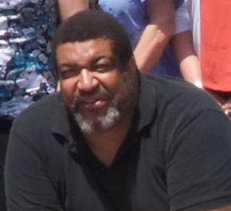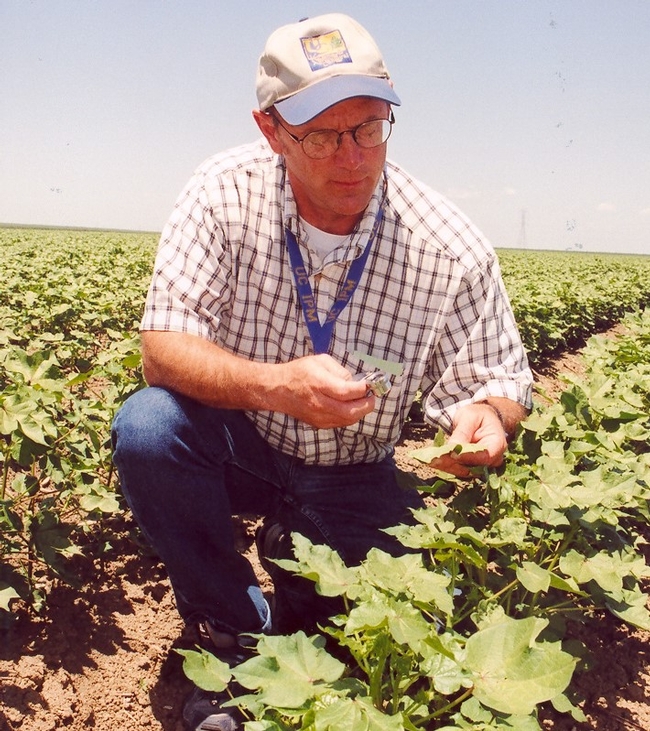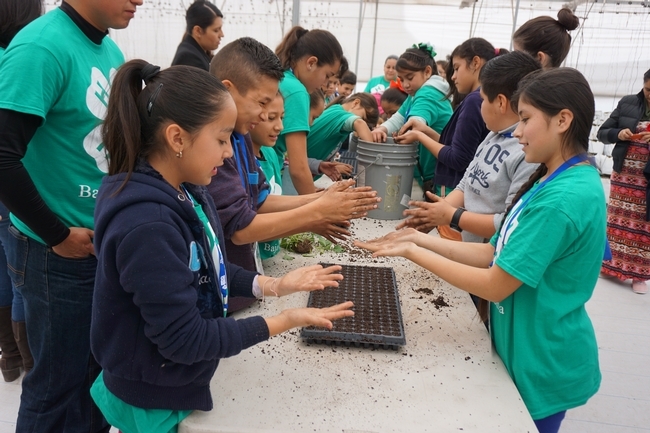Posts Tagged: UC IPM
Marty Martino retires from UC IPM
Marty Martino, UC IPM computer resource specialist, retired Feb. 28 after serving UC for over 29 years. He started working for the university in 1989 and joined the UC IPM Program in 1994.
He has been an outstanding addition to the UC IPM IT/production team for more than 25 years as the computer resource specialist (CRS) and meteorology assistant. As the UC IPM CRS, Martino's primary responsibilities included keeping everyone's computer running and updated, helping with loading webpages, and updating the water-related risk tools (WaterTox online in 2004) and weed susceptibility databases. He also ensured that the weather data is accurate and available for the pest weather models, such as the fire blight degree-day model, grape powdery mildew index, and various insect degree-day models.
Long-time UC Integrated Pest Management advisor Pete Goodell retires June 30
A 36-year career in science led UC Cooperative Extension Integrated Pest Management advisor Pete Goodell to a gratifying conclusion. He found that technical pest management skills are critical, but it's the people skills he has developed over time that were key to bringing about change.
Goodell retires June 30 from what he described as a fulfilling and challenging career that he entered by pure happenstance. His role as a researcher, leader and teacher turned out to be the perfect profession for someone with his interests, skills and passion.
Unable to find a job in forestry after completing an ecology degree at California State University, San Francisco, Goodell answered an ad he saw on a UC Berkeley bulletin board seeking staff to collect insect samples in a hot Los Baños cotton field.
“It wasn't what I wanted, but it got me outdoors and it was very satisfying,” Goodell said. “I was able to use a lot of what I learned in field biology at San Francisco State.”
The job opened the door into the world of agricultural entomology, a scientific field that impacts the most basic of human endeavors, food production. Captivated by the opportunity to make a difference, Goodell continued his education at UC Riverside, where he studied nematology, entomology and plant pathology, earning masters' and doctorate degrees. Just as his education wound down in the early 1980s, there were rumblings in the California State Legislature about the implementation of new regulations aimed at reducing pesticide use.
Jim Farrar, director of the Statewide UC IPM Program, attributed a large part the program's success to Goodell's contributions.
“Pete delivered innovative IPM programs ranging from technical pest sampling strategies to the social science of how people learn and adopt new pest management techniques,” Farrar said.
In the early days, the program focused on producing IPM manuals for the crops that were the highest pesticide users. Teams were established to research, collect and deliver best practices for alfalfa, grapes, walnuts, almonds, rice, cotton, tomatoes and citrus pest management.
“In the UC IPM program we worked together across disciplines, so we got a lot done,” Goodell said.
Today a library of integrated pest management books, leaflets, training resources, websites and blogs deliver UC's best information on managing pests using safe and effective techniques and strategies that protect people and the environment.
The list of Goodell's accomplishments and awards is long. To name just a few, his efforts have been recognized with two Distinguished Service Awards from UC Agriculture and Natural Resources, a Lifetime Achievement Award from the Association of Applied IPM Ecologists, and even being named by US News and World Report as one of the “Ten Most Indispensable Americans.”
One of the concepts that has defined his career is regional integrated pest management, which pushes the management of pests beyond the boundaries of individual farms.
“When you have a mobile insect, one farmer's decisions can impact the entire community,” Goodell said. “Working together, you can mitigate that problem.”
Goodell worked closely with farmers in the Tulare Lake basin to implement a regional IPM management system. Goodell brought together 10 growers, each managing several hundred thousand acres of farmland, to collaborate on the Lygus bug problem in cotton.
“Lygus bugs build up in safflower. When the safflower is harvested, all the bugs move into cotton and you have to spray pesticides,” Goodell said.
Safflower is an important part of the crop rotation system, so Goodell got the farmers together to decide on a management scheme.
“One acre of safflower can infest 10 acres of cotton. If you spray the safflower, you reduce the area sprayed by a factor of 10,” he said. “The growers all agreed to spray safflower on the same day, before the Lygus bugs get their wings and lay eggs. This reduced pesticide use considerably.”
The coordination was a complex process. “I was privileged to work with such a motivated and engaged community of farmers,” Goodell said.
The same kind of regional management was proposed for a group of growers near Firebaugh, but Goodell found it nearly impossible.
“In the Firebaugh area, numerous farmers with small fields and tremendous diversity of crops was an insurmountable challenge,” Goodell said. “But in the Tulare Lake basin, we showed that regional IPM can work. This is a model that can be used for other insect and disease problems in the future, such as Asian citrus psyllid and glassy winged sharpshooter.”
Goodell has applied for emeritus status to continue his work in collaborative entomology during retirement. He and his colleagues plan to bring together a diverse group of Californians to enhance understanding of pests, pesticides, and integrated pest management.
“We'll have farmers, pest control advisers, farmworkers, day care operators and managers of open areas like golf courses and public parks all in the same room,” Goodell said. “We want to understand where we need our research to be going, and how to bridge the gap between those who think all pesticides are bad and those who believe pesticides are critical to their businesses.”
In retirement, Goodell will also pursue his passion for the Great Outdoors. He plans to hike the John Muir Trail one segment at a time, and visit the National Parks in the western United States in style, by staying at historical lodges.
Getting reservations won't be a problem. “We have a very open calendar,” Goodell said.
AVP Powers announces 51 proposals invited for competitive and high-reward grants
AVP Wendy Powers announced the letters of intent (LOIs) for which principal investigators have been invited to submit full proposals to ANR's Competitive Grants Program and High-Risk/High-Reward Grants Program. The list of 51 approved projects can be found at http://ucanr.edu/sites/anrstaff/files/261626.pdf.
This year ANR received a total of 108 letters of intent — 97 for the Competitive Grants Program and 11 for the High-Risk/High-Reward Grants Program. Strategic Initiative leaders and their respective panels reviewed all letters of intent thoroughly to address the appropriateness of the proposals in addressing the goals and criteria outlined by each funding opportunity.
ANR Competitive Grants Program
The purpose of the ANR competitive grants program is to address high-priority issue areas identified by at least one of the strategic initiatives: Endemic and Invasive Pests and Diseases (EIPD), Healthy Families and Communities (HFC), Sustainable Food Systems (SFS), Sustainable Natural Ecosystems (SNE), and Water Quality, Quantity and Security (Water).
ANR Competitive Grants Program 2017 Cycle:
- Full proposals due June 19
- Technical peer review: mid-June – early September 2017
- Strategic Initiative review and recommendations: end of September 2017
- Program Council review and recommendations: October/November 2017
- Announcement of funded grants: November/December 2017
High-Risk/High-Reward Grants Program
Given the complexity of societal problems, high-risk research is necessary to achieve gains for real progress in addressing present and emerging challenges. This program will provide funds to initiate and complete research and proof-of-concept efforts that serve as the basis for larger funding opportunities. These projects must be of a high-risk/high-reward nature that are best conducted in a controlled, research setting and, if successful, lend themselves to subsequent larger funding opportunities and/or intellectual property development.
Proposed projects must be within the scope of the ANR Strategic Vision. All ANR academics with PI status are eligible to apply. Proposals will be accepted using the same timeline as outlined for the traditional competitive grants program, but reviewed separately due to the nature of the proposal.
For questions about ANR's competitive grants program or high-risk/high-reward grants program, please contact Melanie Caruso at mmcaruso@ucanr.edu.
Nutrition Policy Institute launches Research to Action news brief
The Nutrition Policy Institute has launched a news brief called Research to Action. The publication will provide information on research, policy, news, announcements, events, articles and action items focused on nutrition and healthy communities.
The first issue looks at the work of the National Drinking Water Alliance (NDWA). NPI is the “hub” for NDWA, which engages in and coordinates evidence-based efforts going on all over the country to improve tap water safety and access, especially for children, and to provide drinking water education and promotion. The NDWA website is a “go-to” resource for information on drinking water.
Future editions of Research to Action will be sent several times per year. Please sign up for the Research to Action mailing list, and please share Research to Action with colleagues who would be interested in receiving it.
4-H calls alumni and friends to join its new network
If 4-H has touched your life, raise your hand. Visit http://4-H.org/raiseyourhand to voice your support for the California 4-H youth development program, help it win a national competition and connect with a network of 4-H alumni and friends.
You are considered alumni if you were in a 4-H Club, took part in a 4-H after-school program, served as a volunteer leader or taught a project. Friends of 4-H are also invited to raise their hands.
“Having experienced our programs first-hand, our alumni know about the positive impact of 4-H,” said Glenda Humiston, vice president of UC Agriculture and Natural Resources and a 4-H alumna.
As part of the new 4-H network being built in the 4-H Raise Your Hand campaign, members will get news about 4-H programs in California and stay in touch with a program that made a difference in their lives.
“I've raised my hand,” said Humiston, who credits 4-H with helping her become the first in her family to attend college. She later served in the Peace Corps, received a federal appointment from President Obama and now leads the statewide research and outreach arm of UC.
The National 4-H program, which currently empowers nearly 6 million youth across the country, aims to extend its reach to 10 million by 2025. It has launched a competition among states to see which ones can add the most alumni and friends to the network by June 30, 2017. A map showing the current front runners is on the registration page.




